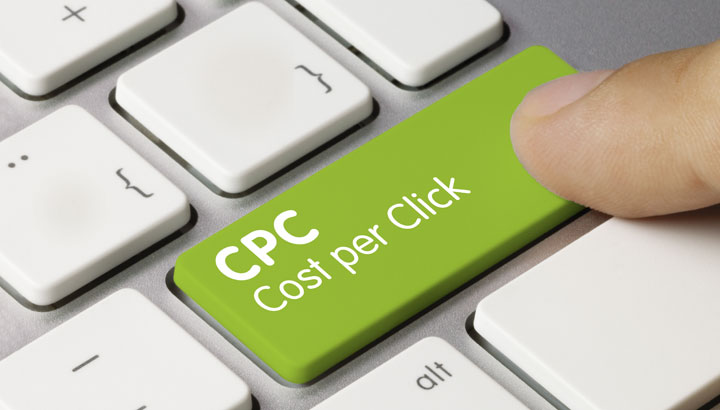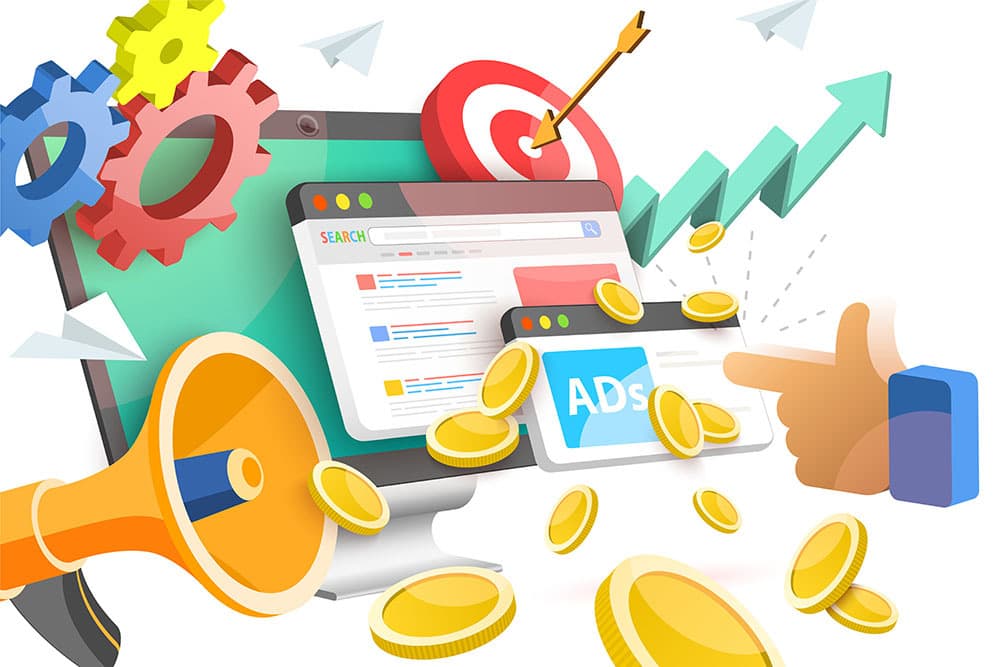CPC is a fairly common term in Marketing – advertising campaigns. However, not everyone clearly understands the concept of what CPC is ? So the following article of MarkKnow will help you answer and summarize all information related to CPC.
What is CPC Index?

What is CPC? CPC (Cost Per Click) is an online advertising pricing model in which advertisers pay each time a user clicks on their ad. Simply put, the cost an advertiser pays depends on the number of clicks the ad receives, rather than the number of impressions the ad is displayed.
Some key features of CPC:
- Pay Only when someone clicks on your ad and interacts with it. This allows you to optimize your costs by focusing on clicks that are likely to convert.
- Widely Used: CPC is a popular model in advertising platforms like Google Ads, Facebook Ads, Instagram Ads, and other search ad networks.
- Keyword bidding: In search advertising campaigns like Google Ads, CPC is typically based on a keyword auction system, where advertisers bid on keywords for which they want their ads to appear.
The Role of CPC in Advertising
CPC plays an important role in optimizing advertising campaigns, especially on platforms like Google Ads, Facebook Ads, and other search engines. Here is the role of CPC in advertising with specific aspects:
Cost Optimization
When using CPC, businesses only have to pay when someone clicks on the ad instead of paying by the number of impressions (CPM – Cost Per Mille). Thus, businesses can optimize costs, pay when the ad achieves the action goal (clicks), bringing higher efficiency with the available budget.
Measuring Performance
CPC provides detailed metrics on ad performance, allowing advertisers to easily track and measure campaign effectiveness. The number of clicks, click-through rate (CTR) and other parameters will reflect the level of viewer interest, thereby more accurately assessing the effectiveness of the ad.
Focus on Target Audience
CPC also helps advertisers reach their target audience more precisely. By targeting based on criteria such as keywords, geographic location, interests, or user behavior, businesses can optimize their campaigns so that their ads are only shown to people who are likely to be interested in and click on them.
Flexible Adjustment
With the CPC model, advertisers can easily adjust factors such as budget, bid, keywords, and target audience in real time. This is essential for businesses to promptly optimize advertising campaigns when there are changes in market demand or advertising effectiveness.
Optimize ROI
Because you only pay when someone clicks on your ad, the CPC model often increases your return on investment (ROI). By targeting the right audience and optimizing your campaign, each click can result in a higher conversion value, increasing your return on investment.
Advantages and Disadvantages of CPC

CPC has many advantages, helping businesses reach a large number of customers interested in products and services. However, it also has some limitations. Specifically about these advantages and disadvantages, MarkKnow will provide them to you in the content below.
Advantages
Ensure Budget Optimization Goals
With the CPC model, businesses only pay when someone clicks on their ads, which helps businesses closely control their advertising budget. Businesses can easily set a daily or campaign budget and only spend on clicks, helping to optimize costs and avoid wasting budget on ads that do not generate interactions.
Understanding Ad Performance
CPC provides accurate and transparent metrics on advertising effectiveness such as the number of clicks, click-through rate (CTR), and average cost per click. Through this, businesses will monitor advertising performance in real-time, thereby assessing which campaigns are performing well and making timely adjustments to achieve better results.
Allows Focus on Interactive Objects
CPC allows you to target the right audience who are likely to be interested in and engage with your business’s ads. By using targeting tools based on keywords, geographic location, interests, or user behavior, your ads will only appear in front of people who are likely to click, thereby improving the quality of interaction and increasing the chance of conversion.
Disadvantages
Costs May Be High
While CPC helps businesses control costs by paying only for each click, bids per click can become very high, especially in highly competitive industries such as real estate, finance, and e-commerce. If not managed properly, advertising costs can quickly increase, leading to spending budget without delivering the expected results.
Clicks Do Not Mean Conversions
High clicks don’t necessarily translate into conversions (like purchases, signups). People may click on your ad but not take the next action you expect. This could be due to a bad landing page, misleading ad copy, or just curiosity. As a result, you’re still paying for each click but not getting any real value.
Every Click is Charged
Another downside to the CPC model is that every click on an ad is charged regardless of user intent, including unwanted clicks from users who accidentally clicked or clicked out of curiosity but did not intend to buy. Additionally, click fraud from competitors or automated tools can also waste budget without delivering results.
Only Suitable for Developed Brands
The CPC model is often more suitable for businesses with established brands because they can afford higher bids, better leverage brand recognition to optimize conversion rates, and have the resources to continuously optimize campaigns. Meanwhile, small businesses or businesses without strong brands need to be careful when using CPC to avoid spending too much without getting the expected results.
How Does CPC Work?
To better understand how CPC works, let’s learn more with MarkKnow through the content below.
Quality Score
Quality Score is a very important factor in determining ad rank and actual cost per click. Quality Score is evaluated based on factors such as:
- Expected CTR: Based on past ad performance, the system estimates how likely it is that users will click on your ad.
- Ad Relevance: Your ad must be relevant to the keyword and user search needs.
- Landing Page Experience: The landing page should provide a good experience, be easy to use, and have content relevant to the ad.
A high Quality Score will help reduce actual CPC bids, improve ad rankings, thereby helping you optimize your advertising budget while still achieving high efficiency.
Ad Ranking
Ad Rank is the formula used to determine where an ad appears relative to its competitors.
Recipe:
| Ad Rank = Rank of Advertisers below you / Your Quality Score + $0.01 |
Quality Score plays an important role in ad ranking. If your Quality Score is high, you can rank higher without having to bid the highest.
This way, your ad will rank high and likely get more clicks, even if you don’t spend more than a competitor with a lower quality score.
CPC Bidding Strategy
There are different bidding strategies to optimize your advertising campaign, depending on your business’s advertising goals. Here are some common strategies:
- Manual CPC Bidding: Businesses set their own bids for each click based on their budget and goals. This allows businesses to closely control their budgets but also requires businesses to constantly monitor and adjust their bids.
- Automatic CPC Bidding: The advertising system automatically sets bids to maximize the number of clicks within the business’s budget, saving management time but can lead to higher costs if not optimized.
CPC Calculation Formula

To calculate CPC costs in an advertising campaign, apply the following formula:
| CPC = (LPQS x ACQS x CTR)/R |
In there:
- Landing Page Quality Score: the SEO score on the landing page of your website.
- Ad Copy Quality Score: score based on SEO criteria with ad content.
- CTR (Click-through Rate): this is the ratio of the number of people who clicked on the ad/the total number of people who viewed the ad.
- Ranking: the position of the ad on Google according to the keyword. The higher the position, the higher the price.
CPC Optimization Methods
Applying CPC for advertising brings many benefits to businesses. However, not all units can do it effectively and optimize advertising costs. Below are some methods compiled by MarkKnow, you can refer to and apply to your business’s advertising campaign.
Increase Quality Score
Google has a lot of good policies for customers, including reducing costs for CPCs with high quality scores. This means you will need to improve and increase your quality score as much as possible.
Some criteria for evaluating quality scores are:
- Is the click-through rate high or low?
- How tight and connected are the ad groups and keywords?
- Is the landing page invested in, polished in terms of content and information, and does it motivate users to buy?
Increase Reach
In addition to quality score, the reach of the ad also needs to be high to reduce the prices of CPC. You need to eliminate fake clicks that waste budget without bringing efficiency.
To do this, you should learn and research new click techniques that will help bring in the necessary, valuable data and metrics for your strategy.

Adjusting Reach
When running Google Ads, regularly using negative keywords in your Ads account can help you control your average CPC . At the same time, this method also helps eliminate traffic that is difficult to convert.
Therefore, when putting keywords in your ads, make sure you carefully select the right target words, ensuring that:
- Optimized Budgets such as reducing costs for useless clicks, paying low prices for irrelevant clicks, etc.
- Improved Quality Score: if the keyword is relevant to your ad content, landing page, offer, etc., the quality score will be highly appreciated and increased.
Experiment With Multiple Display Ranks
CPC costs are based on rank, the higher the position, the higher the price. So the best way to reduce your CPC costs is to try targeting different rankings and measure the impact, click-through rate and conversion.
For example, if your ad shows up in top 1 or top 2 and is equally effective, there is no reason to pay more to compete for top 1.
Choose Multiple Ad Scheduling Times
Don’t just choose one time to run ads if it’s not effective. If running at this time is too expensive, you can change to another time to test, maybe the reach is still good but the cost is reduced.
Using Your Brand Keywords
Nowadays, many people use the method of running ads with keywords related to their competitors’ brand names. Although there will be disadvantages in search volume and quality score, however, this is an effective trick. You just need to optimize your quality score, your CPC will gradually decrease. Even if your competitor is ranked 1st, it is not too important when the value that ranks 1 and 2 bring is sometimes equal.
Cooperate with Professional Advertising Units
If a business runs CPC for an advertising campaign but it is not effective, it can consider choosing an external advertising unit. Currently, there are many professional advertising units. They have experience in the advertising field, so they will definitely help businesses optimize CPC more effectively.
Some Notes When Running CPC Ads

When using CPC in Google advertising , you need to note the following important issues:
- Choose the Right Keywords: Keywords are an important factor in determining the success of CPC advertising, especially in Google Ads. Use tools like Google Keyword Planner to find relevant keywords with high search volume and low competition.
- Use Attractive Images: For social media ads, creative, unique images will attract more clicks.
- Adjust Your Bid Accordingly: CPC bids affect how often and where your ads appear. So your bids should be competitive enough to get good ad placements, but not so high that you waste your budget.
- Focus on Your Target Audience: When running CPC ads, you should segment your audience in detail based on demographics, interests, behaviors, and geographic location to reach the group of people most likely to engage with your ads.
- Real-Time Optimization: Don’t hesitate to change ads, adjust bids, or test new keywords based on data analysis.
- Budget Control: To avoid going over budget, set a daily budget for your CPC advertising campaign. This helps you control your spending and adjust your campaign accordingly.
- Prioritize Spending on Effective Keywords: Spend more budget on keywords and campaigns that are performing well, while reducing spending on keywords that don’t deliver much value.
- Multi-platform Advertising: Make sure your ads appear on multiple devices (desktop, mobile, tablet) to reach your full audience. Tailor your ad format and content to each device.
Distinguishing CPC Index From Other Indexes
CPC is one of the most popular advertising payment models, it is different from other indicators in the field of online advertising, specifically:
CPC vs CPM
- CPC: Advertisers pay when someone clicks on their ad, regardless of how many times the ad is shown. This saves money if your ad gets a lot of views but few clicks.
- CPM (Cost Per Mille): Advertisers pay for every 1,000 times their ad is displayed (Mille = 1,000). CPM is suitable for campaigns that focus on increasing brand awareness rather than clicks.
CPC vs CPA
- CPC: Businesses pay each time a user clicks on an ad, regardless of whether they take a conversion action (purchase, sign up, etc.).
- CPA (Cost Per Action): Advertisers only pay when a user takes a specific action after clicking on an ad, such as signing up or making a purchase. CPA typically costs more than CPC but provides better control over conversion efficiency.
CPC vs PPC
- CPC: This is a measure of the cost an advertiser pays for each click on an ad.
- PPC (Pay Per Click): Is an advertising model in which advertisers pay based on the number of clicks on their ads. PPC is a payment model, while CPC is a cost metric in the PPC model.
CPC vs CTR
- CPC: Measures the cost per click on an ad.
- CTR (Click Through Rate): Measures the percentage of users who click on an ad compared to the number of times the ad is displayed.
| CTR = (Clicks / Impressions) x 100%. |
This index helps evaluate the effectiveness of advertising in terms of attractiveness.
CPC Vs CPV
- CPC: Pay each time a user clicks on your ad, regardless of how many times the ad is displayed.
- CPV (Cost Per View): Used in Video Advertising , advertisers pay for each view of the ad video. For a view to be counted, the user must watch at least part of the video (usually 10 – 30 seconds depending on the platform).
CPC vs CPI
- CPC: Cost per click on an ad.
- CPI (Cost Per Install): Advertisers pay when a user clicks on an ad and installs a mobile app from a link in the ad. CPI is commonly used in app promotion campaigns.
CPC Vs CPL
- CPC: Pay for each click on an ad regardless of the user’s next action.
- CPL (Cost Per Lead): Advertisers pay when a user clicks on an ad and then takes an action that results in a “lead,” such as filling out personal information or signing up for a newsletter. CPL helps measure the effectiveness of customer data collection.
Hopefully, through the above sharing, readers have clearly understood what is CPC and the information surrounding CPC. If you have any questions, you can leave a comment, MarkKnow will help you answer.
Frequently Asked Questions
What is Average CPC?
Average CPC is understood as the average cost for each time a customer clicks on an ad. Because ads change rankings constantly, there is no fixed number to measure CPC.
What is Max CPC?
Maximum CPC is the highest cost a business is willing to pay for advertising. However, based on many factors such as brand relevance and search quality score, the CPC a business has to pay is often lower than the initial bid.
How Can Brands Start Advertising and Determine CPC?
Brands can start advertising using a platform like Google Ads, which determines CPC through keyword bidding based on budget and campaign goals.
What is the difference between Automatic and Manual CPC?
Auto CPC automatically adjusts bids, while manual CPC allows businesses to set their own bids for each click.
What is CPC Code?
CPC codes in ads are ad tracking IDs or URL parameters added to ad paths to track performance.
Comment Policy: We truly value your comments and appreciate the time you take to share your thoughts and feedback with us.
Note: Comments that are identified as spam or purely promotional will be removed.
To enhance your commenting experience, consider creating a Gravatar account. By adding an avatar and using the same e-mail here, your comments will feature a unique and recognizable avatar, making it easier for other members to identify you.
Please use a valid e-mail address so you can receive notifications when your comments receive replies.
